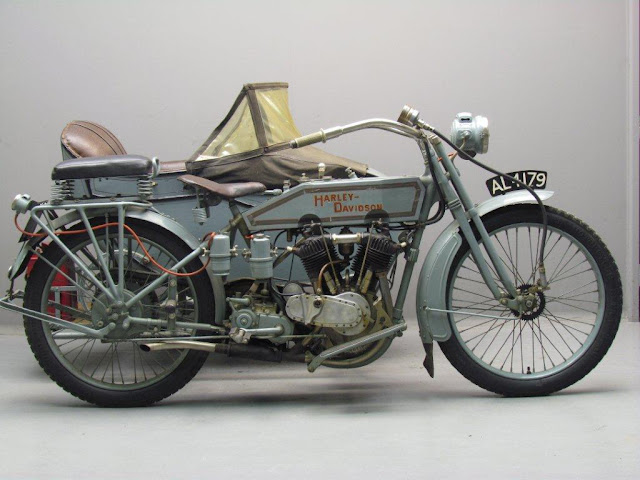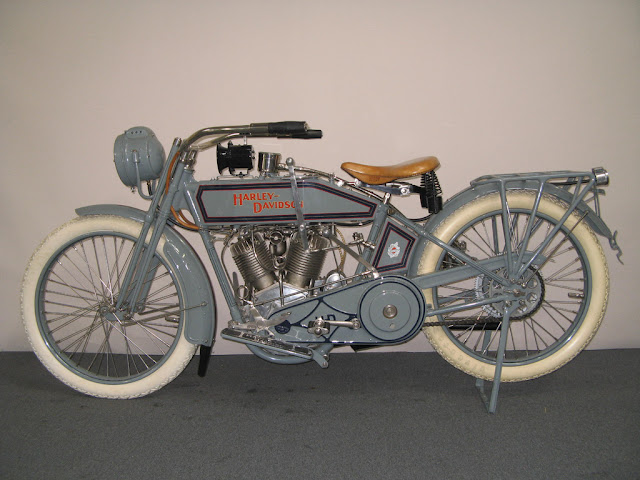Harley-Davidson Model 11F
Like several other American manufacturers in motorcycling’s early years, Harley-Davidson decided that two single-cylinder engines would make a useful twin, especially if set at 45 degrees apart.
The Model llF’s performance was often exciting, especially given the fact that the bike had no front brake and only a crude expanding band system on the rear wheel.
The Model 1 IF of 1915 proved that Harley-Davidson’s founders learned fast when it came to building V-twin motorbikes. The 1 IF was a good-looking, efficient and deservedly popular machine. Its 989cc V-twin engine produced about lObhp, good for a top speed of about 60mph (97km/h), and the bike came with up-to-date features including footboards and chain final drive.
Yet the Milwaukee firm’s founders, William Harley and the three Davidson brothers (Arthur, Walter and William), had suffered a serious setback six years earlier when, encouraged by the success of their pioneering single-cylinder models, they had introduced their first V-twin. The Model 5D of 1909 had an 81 lcc engine, with cylinders set at the 45-degree angle that would become a Harley trademark. It produced about 7hp, twice as much as the firm’s single. But the 5D was hard to start, suffered from technical problems including a slipping drive belt, and was promptly withdrawn from the market.
This did not deter William Harley and the Davidsons, whose robust single-cylinder models were increasingly in demand. The quartet had founded the firm in 1903, in a small shed in the Davidsons’ yard. Their early single became known as the Silent Grey Fellow, due to its colour and efficient exhaust muffler. Production rose dramatically, from just 49 bikes in 1906 to more than 3000 in 1910 - by which time the firm had moved to larger premises in what would become Juneau Avenue, still the current address.
The next year, Harley-Davidson reintroduced the V-twin as the Model 7D. (H-D regarded 1904 as year zero, so 1911 was the seventh model year.) It featured an improved valve system, still with the original inlet-over-exhaust layout, plus a tensioner for the drive belt. It also had a new, stronger frame. This was a much improved bike, but William Harley, the firm’s chief engineer, did not rest on his laurels. During the next few years he introduced a host of improvements that established Harley- Davidson as one of America’s leading manufacturers.
‘Ful Floteing’ system
For 1912 the V-twin was made available with a larger 989cc engine, developing 8bhp, and could be ordered with the option of a clutch (in the rear wheel hub), and with chain instead of belt final drive. Further improvements included a more sophisticated lubrication system, a new frame that gave a lower seat, and a sprung seat post - the curiously named ‘Ful Floteing’ system - for added comfort. Two years later came more advances: footboards, enclosed valve springs, a kickstarter and two-speed transmission.
By 1915, when the Model 1 IF was introduced. Harley had established a V-twin format that would hold the firm in good stead for the next 15 years. Although other refinements would soon be added.
Notably with the three-speed Model J, Harley had produced a big V-twin whose performance and strength would win many admirers, until it was replaced by the side-valve V Series in 1930.
For Harley, 1915 was memorable for another reason too: the firm’s first competition success. After initial resistance to racing at the Milwaukee factory, ex-racer Bill Ottaway had been hired to run a factory team, and had developed a tuned and lightened version of the V-twin, the 1 IK. After breakdowns in its first season, the 1 OOmph (161 km/h) 1 IK took its rider Otto Walker to victory, against factory opposition, in two prestigious 300-mile (483km) races. Harley’s hard- riding ‘Wrecking Crew’ would have many more wins in the years to come, many of them on powerful, purpose-built, eight-valve V-twins.
The llF’s two-speed gearbox was operated by hand using a lever to the left of the tank. Another job for the rider was to lubricate the motor using a hand-operated oil pump.
Although some rival firms including Indian offered a basic form of rear suspension, Harley stuck to a ‘hard-tail’frame, and improved the rider’s comfort with a sprung saddle and ‘Ful Floteing ’ seat post design.
Specification Harley-Davidson Model 11F (1915)
- Engine Air-cooled four-valve inlet-over-exhaust 45-degree V-twin
- Capacity 989cc (84 x 88.9mm)
- Maximum power 10bhp
- Transmission Two-speed, chain or belt final drive
- Frame Steel single downtube
- Suspension Girder forks; rigid rear
- Brakes None front; expanding band rear
- Weight 3101b (141kg)
- Top speed 60mph (97km/h)



















0 comments: